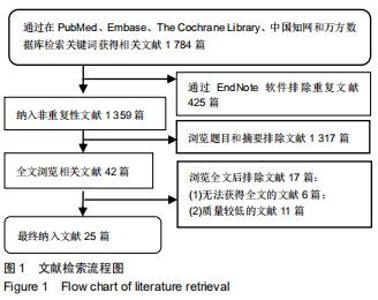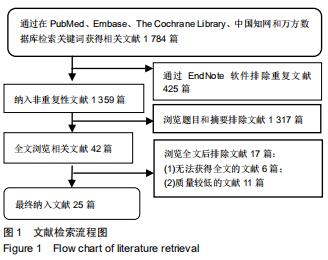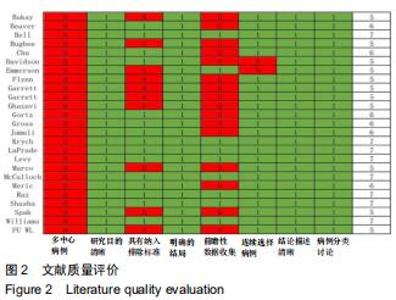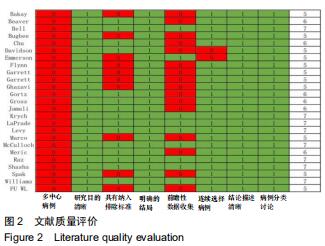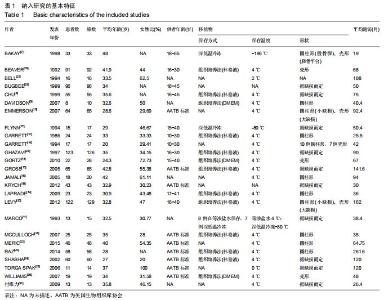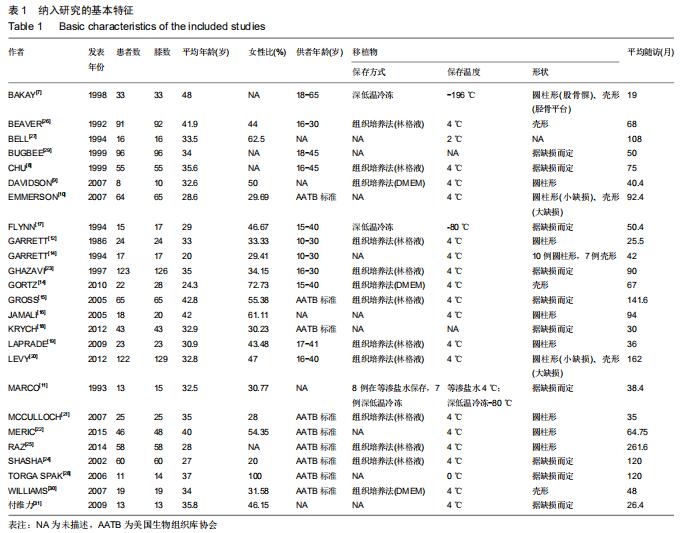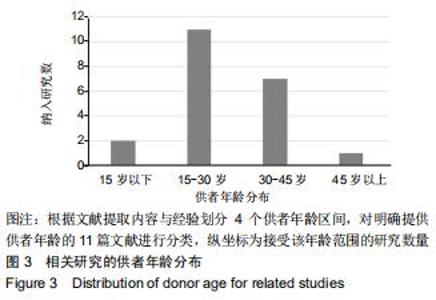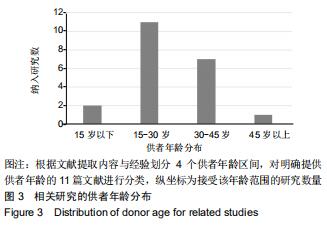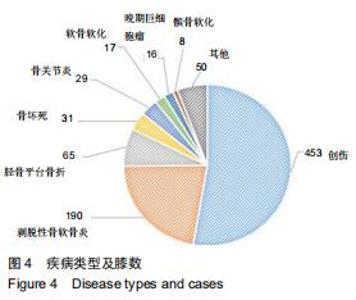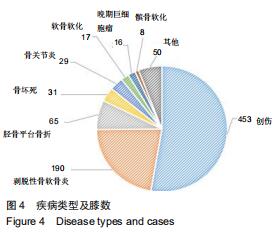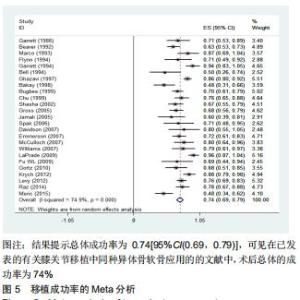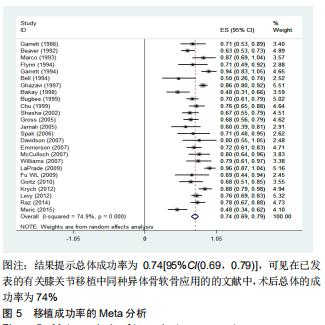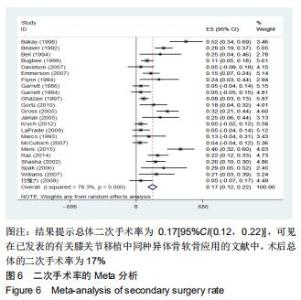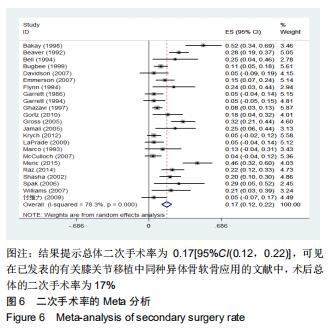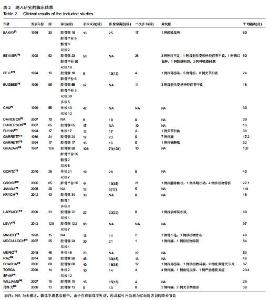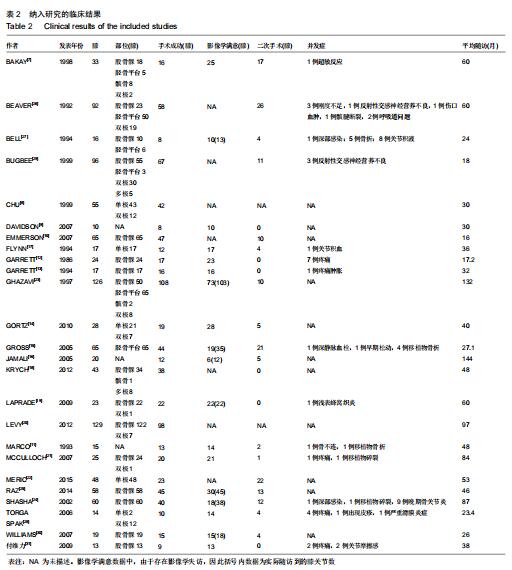Chinese Journal of Tissue Engineering Research ›› 2020, Vol. 24 ›› Issue (27): 4406-4413.doi: 10.3969/j.issn.2095-4344.2742
Previous Articles Next Articles
Effectiveness and safety of osteochondral allograft transplantation in the knee joint: a meta-analysis
Hua Kunchi, Feng Jiangtao, Hu Yongcheng
- Department of Bone Tumor, Tianjin Hospital, Tianjin 300211, China
-
Received:2019-12-02Revised:2019-12-06Accepted:2020-01-16Online:2020-09-28Published:2020-09-10 -
Contact:Hu Yongcheng, MD, Chief physician, Professor, Doctoral supervisor, Department of Bone Tumor, Tianjin Hospital, Tianjin 300211, China -
About author:Hua Kunchi, Master candidate, Department of Bone Tumor, Tianjin Hospital, Tianjin 300211, China
CLC Number:
Cite this article
Hua Kunchi, Feng Jiangtao, Hu Yongcheng. Effectiveness and safety of osteochondral allograft transplantation in the knee joint: a meta-analysis[J]. Chinese Journal of Tissue Engineering Research, 2020, 24(27): 4406-4413.
share this article
|
[1] 赵光辉,贺强,马建兵,等.全膝关节置换术治疗胫骨平台骨折后创伤性关节炎中期疗效[J].实用骨科杂志,2019,34(9):790-794.
[2] 王斌,席智杰,梁倩倩,等.基质诱导自体软骨细胞移植治疗股骨滑车软骨损伤[J].中国修复重建外科杂志,2017,2017(1): 104-110.
[3] LIU Z, CHEN S, YANG Y, et al. MicroRNA-671-3p regulates the development of knee osteoarthritis by targeting TRAF3 in chondrocytes. Mol Med Rep. 2019;20(3): 2843-2850.
[4] KRILL M, EARLY N, EVERHART JS, et al. Autologous chondrocyte implantation (aci) for knee cartilage defects: a review of indications, technique, and outcomes. JBJS Rev. 2018; 6(2): e5.
[5] 韩运宁,亓建洪.体外组织培养法保存关节软骨的研究进展[J]. 中国医药生物技术, 2017,12(6):560-562.
[6] 陶开亮,高兴,顾庆陟,等.兔关节软骨下骨缺损骨移植后移植骨组织学变化实验研究[J].中华移植杂志(电子版),2017,11(3): 154-159.
[7] BAKAY A, CSONGE L, PAPP G, et al. Osteochondral resurfacing of the knee joint with allograft. Int Orthop. 1998; (1998): 277-281.
[8] CHU CR, CONVERY FR, AKESON WH, et al. Articular cartilage transplantation. Clin Orthop Relat Res. 1999;360: 159-168.
[9] DAVIDSON PA, RIVENBURGH DW, DAWSON PE, et al. Clinical, histologic, and radiographic outcomes of distal femoral resurfacing with hypothermically stored osteoarticular allografts. Am J Sports Med. 2007;35(7):1082-1090.
[10] EMMERSON BC, GORTZ S, JAMALI AA, et al. Fresh osteochondral allografting in the treatment of osteochondritis dissecans of the femoral condyle. Am J Sports Med. 2007; 35(6): 907-914.
[11] MARCO F, LOPEZ-OLIVA F, FEDZ-ARROYO JMF, et al. Osteochondral allografts for osteochondritis dissecans and osteonecrosis of the femoral condyles. Int Orthop.1993;17(2): 104-108.
[12] GARRETT JC. Treatment of osteochondral defects of the distal femur with fresh osteochondral allografts: a preliminary report. Arthroscopy. 1986;2(4): 222-226.
[13] GARRETT JC. Fresh osteochondral allografts for treatment of articular defects in osteochondritis dissecans of the lateral femoral condyle in adults. Clin Orthop Relat Res. 1994; 1994(303): 33-37.
[14] GORTZ S, DE YOUNG AJ, BUGBEE WD. Fresh osteochondral allografting for steroid-associated osteonecrosis of the femoral condyles. Clin Orthop Relat Res. 2010;468(5):1269-1278.
[15] GROSS AE, SHASHA N, AUBIN P. Long-term followup of the use of fresh osteochondral allografts for posttraumatic knee defects. Clin Orthop Relat Res. 2005; (435): 79-87.
[16] JAMALI AA, EMMERSON BC, CHUNG C, et al. Fresh osteochondral allografts. Clin Orthop Relat Res. 2005; (437):176-185.
[17] FLYNN JM, SPRINGFIELD DS, MANKIN HJ. Osteoarticular Allografts to Treat Distal Femoral Osteonecrosis. Clin Orthop Relat Res. 1994;1994(303):38-43.
[18] KRYCH AJ, ROBERTSON CM, WILLIAMS RJ. Return to athletic activity after osteochondral allograft transplantation in the knee. Am J Sports Med. 2012;40(5):1053-1059.
[19] LAPRADE RF, BOTKER J, HERZOG M, et al. Refrigerated osteoarticular allografts to treat articular cartilage defects of the femoral condyles. A prospective outcomes study. J Bone Joint Surg Am. 2009;91(4):805-811.
[20] LEVY YD, GORTZ S, PULIDO PA, et al. Do fresh osteochondral allografts successfully treat femoral condyle lesions? Clin Orthop Relat Res. 2013;471(1):231-237.
[21] MCCULLOCH PC, KANG RW, SOBHY MH, et al. Prospective evaluation of prolonged fresh osteochondral allograft transplantation of the femoral condyle: minimum 2-year follow-up. Am J Sports Med. 2007;35(3):411-420.
[22] MERIC G, GRACITELLI GC, GORTZ S, et al. Fresh osteochondral allograft transplantation for bipolar reciprocal osteochondral lesions of the knee. Am J Sports Med. 2015; 43(3): 709-714.
[23] GHAZAVI MT, PRITZKER KP, DAVIS AM, et al. Fresh osteochondral allografts for post-traumatic osteochondral defects of the knee. J Bone Joint Surg Br. 1997;79(6): 1008-1013.
[24] SHASHA N, AUBIN PP, CHEAH HK, et al. Long-term clinical experience with fresh osteochondral allografts for articular knee defects in high demand patients. Cell Tissue Bank. 2002;3(3): 175-182.
[25] RAZ G, SAFIR OA, BACKSTEIN DJ, et al. Distal Femoral Fresh Osteochondral Allografts: Follow-up at a Mean of Twenty-two Years. J Bone Joint Surg Am. 2014;96(13): 1101-1107.
[26] BEAVER RJ, MAHOMED M, BACKSTEIN D, et al. Fresh osteochondral allografts for post-traumatic defects in the knee. A survivorship analysis. J Bone Joint Surg Br. 1992;74-B(1): 105-110.
[27] BELL RS, DAVIS A, ALLAN DG, et al. Fresh osteochondral allografts for advanced giant cell tumors at the knee. J Arthroplasty. 1994;9(6): 603-609.
[28] TORGA SPAK R, TEITGE RA. Fresh osteochondral allografts for patellofemoral arthritis: long-term followup. Clin Orthop Relat Res. 2006;444: 193-200.
[29] BUGBEE WD, CONVERY FR. Osteochondral allograft transplantation. Clin Sports Med. 1999;18(1): 67-75.
[30] WILLIAMS RJ, RANAWAT AS, POTTER HG, et al. Fresh stored allografts for the treatment of osteochondral defects of the knee. J Bone Joint Surg Am. 2007;89(4):718-726.
[31] 付维力,罗大辉,叶京兵,等.关节镜辅助下同种异体骨软骨移植修复膝关节剥脱性骨软骨炎[J].中国修复重建外科杂志,2009, 23(3): 278-281.
[32] 鲁谊,张海龙,李屹钧.关节镜下微骨折或自体软骨移植术治疗肘关节剥脱性骨软骨炎早期临床疗效[J].中华骨科杂志, 2018, 38(1): 1-7.
[33] 林奕鹏,李韬,熊燕,等.膝关节自体软骨细胞移植术后康复的研究进展[J].中国修复重建外科杂志, 2018,32(6):758-763. [34] LYNCH TS, PATEL RM, BENEDICK A, et al. Systematic review of autogenous osteochondral transplant outcomes. Arthroscopy. 2015;31(4): 746-754.
[35] FRANK RM, COTTER EJ, LEE S, et al. Do outcomes of osteochondral allograft transplantation differ based on age and sex? A comparative matched group analysis. Am J Sports Med. 2018;46(1):181-191.
[36] MORIHARA T, HARWOOD F, GOOMER R, et al. Tissue-engineered repair of osteochondral defects: effects of the age of donor cells and host tissue. tissue Eng. 2002; 8(6): 921-929.
[37] NUELLE CW, NUELLE JA, COOK JL, et al. Patient factors, donor age, and graft storage duration affect osteochondral allograft outcomes in knees with or without comorbidities. J Knee Surg. 2017;30(2):179-184.
[38] BALL ST, AMIEL D, WILLIAMS SK, et al. The Effects of Storage on Fresh Human Osteochondral Allografts. Clin Orthop Relat Res. 2004;418:246-252.
[39] ONUMA K, URABE K, NARUSE K, et al. Allogenic serum improves cold preservation of osteochondral allografts. Clin Orthop Relat Res. 2012; 470(10):2905-2914.
[40] CAO F, QI J, SONG H, et al. Tsmu solution improves rabbit osteochondral allograft preservation and transplantation outcome. Cell Tissue Bank. 2018;19(4):549-558.
[41] PENNOCK AT, WAGNER F, ROBERTSON CM, et al. Prolonged storage of osteochondral allografts – does the addition of fetal bovine serum improve chondrocyte viability? J Knee Surg. 2006;19(4):265-272.
[42] CSONGE L, BRAVO D, NEWMAN-GAGE H, et al. Banking of osteochondral allografts, part ii. preservation of chondrocyte viability during long-term storage. Cell Tissue Bank. 2002; 3(3):161-168.
[43] MALININ T, TEMPLE HT, BUCK BE. Transplantation of osteochondral allografts after cold storage. J Bone Joint Surg Am. 2006; 88(4): 762-770.
[44] COOK JL, STOKER AM, STANNARD JP, et al. A novel system improves preservation of osteochondral allografts. Clin Orthop Relat Res. 2014;472(11):3404-3414.
[45] GARRITY JT, STOKER AM, SIMS HJ, et al. Improved osteochondral allograft preservation using serum-free media at body temperature. Am J Sports Med. 2012;40(11): 2542-2548.
[46] PALLANTE AL, BAE WC, CHEN AC, et al. Chondrocyte viability is higher after prolonged storage at 37 degrees C than at 4 degrees C for osteochondral grafts. Am J Sports Med. 2009;37(Suppl 1): 24S-32S.
[47] QI J, HU Z, SONG H, et al. Cartilage storage at 4℃ with regular culture medium replacement benefits chondrocyte viability of osteochondral grafts in vitro. Cell Tissue Bank. 2016;17(3): 473-479.
[48] ROBERTSON CM, ALLEN RT, PENNOCK AT, et al. Upregulation of Apoptotic and Matrix-related Gene Expression during Fresh Osteochondral Allograft Storage. Clin Orthop Relat Res. 2006;442(NA): 260-266.
[49] YAMADA T, UCHIDA K, ONUMA K, et al. Hydrogen supplementation of preservation solution improves viability of osteochondral grafts. Scientific World J. 2014;2014:109876.
[50] BAE JY, HAN DW, WAKITANI S, et al. Biological and biomechanical evaluations of osteochondral allografts preserved in cold storage solution containing epigallocatechin gallate. Cell Transplant. 2010;19(6):681-689. |
| [1] | Chen Junming, Yue Chen, He Peilin, Zhang Juntao, Sun Moyuan, Liu Youwen. Hip arthroplasty versus proximal femoral nail antirotation for intertrochanteric fractures in older adults: a meta-analysis [J]. Chinese Journal of Tissue Engineering Research, 2021, 25(9): 1452-1457. |
| [2] | Chen Jinping, Li Kui, Chen Qian, Guo Haoran, Zhang Yingbo, Wei Peng. Meta-analysis of the efficacy and safety of tranexamic acid in open spinal surgery [J]. Chinese Journal of Tissue Engineering Research, 2021, 25(9): 1458-1464. |
| [3] | Hu Kai, Qiao Xiaohong, Zhang Yonghong, Wang Dong, Qin Sihe. Treatment of displaced intra-articular calcaneal fractures with cannulated screws and plates: a meta-analysis of 15 randomized controlled trials [J]. Chinese Journal of Tissue Engineering Research, 2021, 25(9): 1465-1470. |
| [4] | Huang Dengcheng, Wang Zhike, Cao Xuewei. Comparison of the short-term efficacy of extracorporeal shock wave therapy for middle-aged and elderly knee osteoarthritis: a meta-analysis [J]. Chinese Journal of Tissue Engineering Research, 2021, 25(9): 1471-1476. |
| [5] | Wang Yongsheng, Wu Yang, Li Yanchun. Effect of acute high-intensity exercise on appetite hormones in adults: a meta-analysis [J]. Chinese Journal of Tissue Engineering Research, 2021, 25(8): 1305-1312. |
| [6] | Kong Desheng, He Jingjing, Feng Baofeng, Guo Ruiyun, Asiamah Ernest Amponsah, Lü Fei, Zhang Shuhan, Zhang Xiaolin, Ma Jun, Cui Huixian. Efficacy of mesenchymal stem cells in the spinal cord injury of large animal models: a meta-analysis [J]. Chinese Journal of Tissue Engineering Research, 2021, 25(7): 1142-1148. |
| [7] | Huang Dengcheng, Wang Zhike, Cao Xuewei. Intravenous, topical tranexamic acid alone or their combination in total knee arthroplasty: a meta-analysis of randomized controlled trials [J]. Chinese Journal of Tissue Engineering Research, 2021, 25(6): 948-956. |
| [8] | Li Yan, Wang Pei, Deng Donghuan, Yan Wei, Li Lei, Jiang Hongjiang. Electroacupuncture for pain control after total knee arthroplasty: a meta-analysis [J]. Chinese Journal of Tissue Engineering Research, 2021, 25(6): 957-963. |
| [9] | He Xiangzhong, Chen Haiyun, Liu Jun, Lü Yang, Pan Jianke, Yang Wenbin, He Jingwen, Huang Junhan. Platelet-rich plasma combined with microfracture versus microfracture in the treatment of knee cartilage lesions: a meta-analysis [J]. Chinese Journal of Tissue Engineering Research, 2021, 25(6): 964-969. |
| [10] | Hua Haotian, Zhao Wenyu, Zhang Lei, Bai Wenbo, Wang Xinwei. Meta-analysis of clinical efficacy and safety of antibiotic artificial bone in the treatment of chronic osteomyelitis [J]. Chinese Journal of Tissue Engineering Research, 2021, 25(6): 970-976. |
| [11] | Zhan Fangbiao, Cheng Jun, Zou Xinsen, Long Jie, Xie Lizhong, Deng Qianrong. Intraoperative intravenous application of tranexamic acid reduces perioperative bleeding in multilevel posterior spinal surgery: a meta-analysis [J]. Chinese Journal of Tissue Engineering Research, 2021, 25(6): 977-984. |
| [12] | Zhong Yuanming, Wan Tong, Zhong Xifeng, Wu Zhuotan, He Bingkun, Wu Sixian. Meta-analysis of the efficacy and safety of percutaneous curved vertebroplasty and unilateral pedicle approach percutaneous vertebroplasty in the treatment of osteoporotic vertebral compression fracture [J]. Chinese Journal of Tissue Engineering Research, 2021, 25(3): 456-462. |
| [13] | Li Yang, Zhang Mingyong. Meta-analysis of the effect of double Endobutton and clavicular hook plate on the treatment of acromioclavicular dislocation [J]. Chinese Journal of Tissue Engineering Research, 2021, 25(3): 463-470. |
| [14] | Li Yanle, Yue Xiaohua, Wang Pei, Nie Weizhi, Zhang Junwei, Tan Yonghai, Jiang Hongjiang. Intramedullary nail fixation versus plate fixation in the treatment of displaced midshaft clavicular fractures in adults: a meta-analysis [J]. Chinese Journal of Tissue Engineering Research, 2021, 25(3): 471-476. |
| [15] | Liu Chang, Han Shufeng. Interlocking intramedullary nail for proximal femur versus proximal femoral anti-rotation intramedullary nail or proximal femoral anti-rotation intramedullary nail of Asian for intertrochanteric fractures in older adults: a meta-analysis [J]. Chinese Journal of Tissue Engineering Research, 2021, 25(3): 477-485. |
| Viewed | ||||||
|
Full text |
|
|||||
|
Abstract |
|
|||||
